DIVE AN AWESOME THREESOME
FLORIDA KEYS - Established by the Florida Keys National Marine Sanctuary, the Florida Keys Shipwreck Heritage Trail was created to encourage an appreciation and understanding of the Keys' maritime heritage.
Early shipwrecks and vessels intentionally sunk to create artificial reefs serve as refuges for fish, delicate corals and invertebrates, and playgrounds for divers. Among this string of notable wreck sites, stretching from Key Largo to Key West, is an "awesome threesome" for advanced- and wreck-certified divers.
Spiegel Grove
Spiegel Grove is currently the third-largest vessel intentionally sunk to make an artificial reef, and is positioned in 130 feet of water about six miles off Key Largo. Designed to carry cargo and craft for amphibious landings, the ship was retired by the Navy in 1989 and spent 12 years tethered in the Navy's "Mothball Fleet" in Virginia's James River.
In June 2001, it was towed to undergo an elaborate cleaning process and 11 months later was relocated off Key Largo.
The retired 510-foot Navy Landing Ship Dock prematurely sank and rolled over May 17, 2002, leaving its upside-down bow protruding above the surface of the water. Three weeks later, a salvage team managed to fully sink the vessel and it came to rest on its starboard side.
After more than three years of welcoming divers in that position, Spiegel Grove benefited from a hurricane that brushed the Florida Keys in July 2005. Much to the surprise of the dive community, waves from Hurricane Dennis pushed the vessel into the upright position originally planned.
Today, the top deck of Spiegel Grove is about 60 feet below the surface of the ocean. The ship is so wide that, on many days, the view of the superstructure will fade into a green-blue abyss. On the clearest days, the sandy bottom is visible at a depth of about 130 feet from the surface. Mooring buoys provide convenient, coral-friendly boat tie-offs.
Dive professionals say that wreck divers intending to enter the upper decks of Spiegel Grove — areas that were prepared to lessen the risk of such activity —must have knowledge and proof of certifications regarding diving in overhead environments.
Thunderbolt
The waters off Marathon are home to the wreck of Thunderbolt, a 188-foot cable layer that later served as a research vessel to explore the electrical energy of lightning strikes. The local dive community purchased Thunderbolt, originally named Randolph, and sank it intentionally as a dive attraction March 3, 1986, in approximately 120 feet of water 6.5 miles south of Duck Key Channel in the Florida Keys National Marine Sanctuary.
The vessel is referred to as the queen of the Marathon wreck fleet.
An easily navigable wreck, Thunderbolt is accessed by following the lines of two submerged mooring balls positioned at the bow and stern. The top of the observation deck is 75 feet beneath the surface. Uniquely, divers can see this wreck in its entirety during one dive, and reportedly visibility is great on any given day. Thunderbolt sits perfectly upright with large angelfish patrolling its decks and notable giant cable spool at the bow; barracuda stand watch in the wheelhouse, an easy and intriguing swim-through. The aft end of the wreck has been cut away to expose the engine room and the interior of the hull.
Thunderbolt’s superstructure is coated with colorful sponges, corals and hydroids, providing refuge and sustenance to large angelfish, jacks, cobia, tarpon and a variety of deep-water pelagic creatures.
Perhaps the most popular residents are the three goliath grouper that hang around the engine room — one nearly 800 pounds. Schools of amberjack, plentiful hogfish, black grouper and the occasional reef shark reside near the rudder and propellers, left on the ship to complement the stern section of the hull to appeal to divers.
Vandenberg
Sunk May 27, 2009, Vandenberg is the second-largest artificial reef in the world, and sits in nearly 150 feet of water approximately seven miles off Key West.
The top of the superstructure, at a depth of approximately 50 feet, is barely visible from the surface, punctuated by the platform-like kingpost and one of the iconic parabolic dish antennae, glowing white and beckoning from below. Algae and soft corals are already growing and are expected to soon cover the hull, causing the white glow to fade and blend in with colors of the ocean life. Over the course of decades the ship’s hull will be densely populated with species of coral, sponges, invertebrates, sea fans and sea whips.
For safety and ease, divers descend along a lead line attached to one of the wreck’s mooring lines, a half dozen of which have been placed intermittently along the 523 feet that stretch from bow to stern.
All dive spots along the superstructure are open, free from obstruction and easy to maneuver around during a dive. Vandenberg is a wreck of plenty, and several return trips are required to appreciate its length — nearly two football fields.
Starting from a vantage point at the bow and moving aft, divers can pause at the eye-catching kingpost and foremast, now a popular underwater photo op for dive buddies, and a rest platform or safety stop during ascension from deeper dives. Divers may need to hold on at these short stops, depending on the conditions of the current.
Continuing aft, neutral divers can drift at anywhere from 55 to 70 feet and see the bridge, and a telescope — part of the star-tracking systems during the Vandenberg’s active duty — mounted on top of the wheelhouse.
Behind the bridge and the main mast is the smaller of the two iconic radar dishes; next, the No. 1 barbette, a heavy steel structure in the shape of a pedestal used as protection for artillery gun turrets on military ships. Aft of the No. 1 barbette is the larger radar dish, which in the 1999 movie “Virus” provided quite an explosive sequence when a laser from space blew the dish off the ship.
Divers beginning their dive at the aft of the ship (it's too large to entirely see in one dive), can see the trimmed part of the foremast with the crow’s nest, as well as the bottom half of the ship’s smokestack. The smokestack's other half, trimmed to approximately 20 feet tall for an even profile along the ship’s structure, sits atop the stern’s weather balloon hangar, dubbed the “underwater Margaritaville” — a clubhouse tribute to the Parrot Head fans of entertainer Jimmy Buffett, who contributed to the Vandenberg project.
Though the Vandenberg delivers a safe, enjoyable dive for certified divers at most experience levels, it is primarily recommended for properly certified and trained advanced and wreck divers.
Be Prepared and Well Trained
For a normal dive on a wreck without penetration, it is recommended (and at certain shops, required) that divers have at least advanced open-water certification or higher. If divers have open-water certification, local dive shops may request that they have their logbook available to be reviewed for air-management skills gained from previous dive history.
Wrecks have overhead environments, and pose a certain risk, so without special instruction and knowledge, they are not meant for the average diver. It is recommended to dive with a local dive center, operators who are professionally skilled and knowledgeable, who will prepare and advise on important dive safety information as well as a dive plan and buddy system.
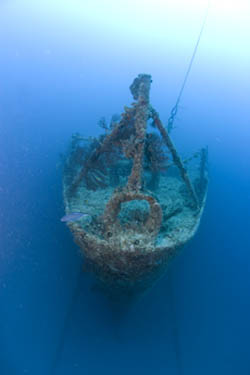
The front of the Spiegel Grove from its current upright position. Photo by Stephen Frink
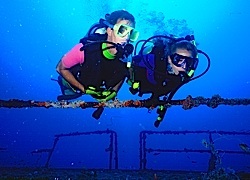
Divers can see the Thunderbolt wreck in its entirety during one dive, with visibility up to 100 feet. Photos courtesy of Hall's Dive Center & International Career Institute
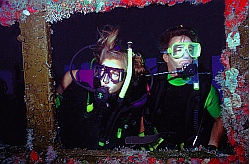
The Thunderbolt’s superstructure is coated with colorful sponges, corals and hydroids, providing refuge and sustenance to large angelfish, jacks, cobia, tarpon and a variety of deep-water pelagic creatures.
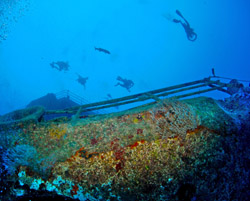
Instructor Jaclyn Skafas examines the Vandenberg's superstructure, near one of the wreck's parabolic tracking dishes. Photo by Stephen Frink.
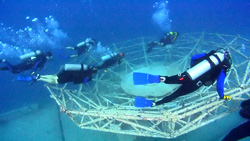
Divers explore above the Vandenberg's weighty superstructure. Photo by Haig Jacobs
